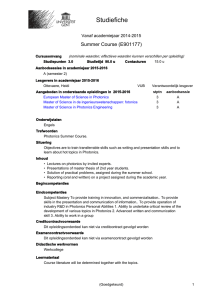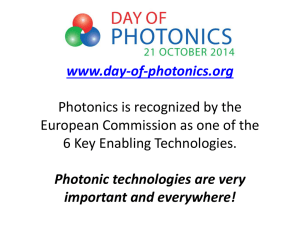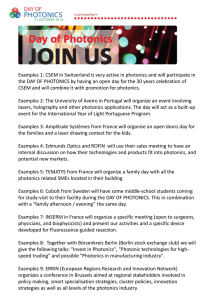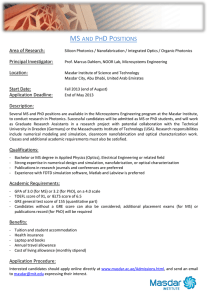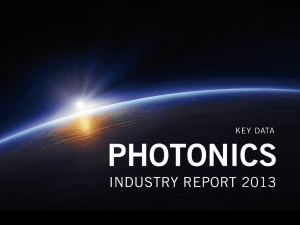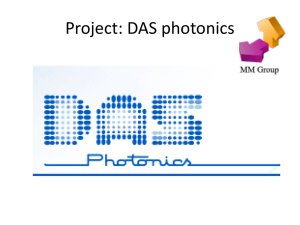Group_4_Korea_Jeong Hop Lee
advertisement
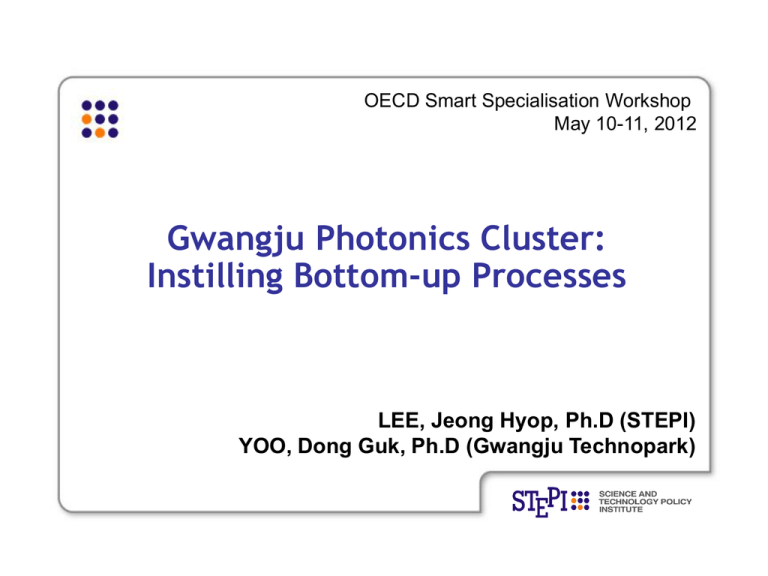
OECD Smart Specialisation Workshop May 10-11, 2012 Gwangju Photonics Cluster: Science & Technology Instilling Bottom-up Processes Policy Institute LEE, Jeong Hyop, Ph.D (STEPI) YOO, Dong Guk, Ph.D (Gwangju Technopark) Contents Introduction Key features of the cluster/domain Regional and national policies that have been decisive for prioritisation of domains Future development of the cluster: grasping the opportunities for smart specialisation? 1. Introduction 1.1 Case study introduction Different context of Smart Specialisation Strategies - Western bottom-up vs. Korean top-down Gwangju photonics cluster - Sharp growth through localization of national strategic industrial programs - Searching for new governing mechanism for new technological opportunities 1 1. Introduction 1.2 Definition of the eco-system and its boundaries Gwangju Photonics cluster: an agglomeration of the photonics industry with strong policy intervention Location of Gwangju and photonics cluster 2 1. Introduction 3 1.2 Definition of the eco-system and its boundaries Photonics cluster and major players •Universities (4): ① Gwangju Institute of Science and Technology (HQ), ② Chosun University (industry-academy campus), ③ Chonnam National University (industry-academy campus), ④ Nambu University (HQ) •Research Institutes (9): ⑤ Advanced Photonics Research Institute, ⑥ Gist Technology Institute, ⑦ Energy and Climate Change Research Center, ⑧ ETRI (Optical Communication Research Center), ⑨ KITECH (Gwangju Research Center), ⑩ KETI (Gwangju Regional Branch), ⑪ National Institute of Environmental Research (Honam Branch), ⑫ Korea Photonics Technology Institute, ⑬ KATECH Gwangju Center •Service agencies (7): ⑭ Gwangju Technopark, ⑮ Korean Industrial Complex Corp., ⑯ Korea Association for Photonics Industry Development, ⑰ Honam Leading Industry Office, ⑱ Gwangju Science and Technology Cooperation Center, ⑲ Gwangju Design Center, ⑳ Green Car Parts Industry Promotion Foundation 2. Key features 2.1 Historical development description Asian Crisis in late 1997 and local consensus for new economic development Localization of national strategic industry from comprehensive advice and opinions from central government, universities, research institutes, etc Two principles of the local Research Committee on S&T Strategy (1998): no duplication with other regions and new industry linked to national strategic industry promotion programs Official announcement of photonics industry vision and promotion strategies (2000) with SERI feasibility study and KIET consulting report 4 2. Key features 2.1 Historical development description Photonics Industry Growth in Gwangju 5 2. Key features 6 2.1 Historical development description Brief history of local economic growth and future direction of Gwangju GRDP in Billion Korean Won 25,000 • 1st Regional Strategic Industrial Promotion Program: Photonics industry in Gwangju 20,000 • Korea Association for Photonics Industry Development 2000) 15,000 • LED/LD center for packing pilot production technology extension (2002) • Korea Photonics Technology Instittute (2001) 10,000 • Gwangju Technopark (1999) • Gwangju Design Center (2005) • 2nd Regional Strategic Industrial Promotion Program: Electronic appliances (2003) • Next Generation Automotive Electronic Parts Center (2007) • 3rd Regional Strategic Industrial Promotion Program: Four strategic industries (2009) • Interregional Networking for New Industrial Promotion 5,000 0 1990 2000 Center of the South West Region 2009 Strategic Industrial promotion 2020 New Regional Industrial Promotion 2. Key features 7 2.2 Key assets in the economic system Major institutes of Gwangju photonics cluster Major institutes Universities Chonnam National University, Chosun University, Gwangju Institute of Science & Technology (GIST), Honam University, Gwangju University, Nambu University, , Donggang College, Gwangju Health College, Chosun College of Science & Technolory, Songwon University Research Institutes Korea Photonics Technology Institute (KOPTI), KITECH Gwangju Research Center, ETRI Optical Communication Research Center, KETI Gwangju Regional Branch, Advanced Photonics Research Institute (APRI), GIST Technology Institute (GTI) Service Agencies Gwangju Technopark, Korean Industrial Complex Corp.(KICOX), Gwangju Information and Culture Industry Promotion agency, Gwangju SME Business Support Center, Korea Association for Photonics Industry Development (KAPID), Korea Institute of Science and Technology Information, Honam Leading Industry Office, Gwangju Design Center, Gwangju Science and Technology Cooperation Center Technology Centers Photonic and Optical Education Learning Center (POEL), Gwanju Digital Electronics Center (JDEC), Human Resources Development Center, University Technology Extension Centers, R&D Center for Titanium and Alloys, LED/LD Center, Home Robot Support Center, Automobile Electronic Center 2. Key features 8 2.2 Key assets in the economic system Functions of major institutes Business incubation R&D Pilot production and equipment services Business assistance services Education and training Technology transfer KOPTI ○ ◎ ◎ ◎ ◎ ○ KITECH ○ ◎ ○ ○ △ △ APRI △ ◎ △ ○ ○ ○ ETRI △ ◎ ◎ ○ △ ○ Gwangju Technopark LED/LD Center ◎ ○ ◎ ◎ △ ◎ KAPID △ △ △ ◎ ○ △ GTI △ ○ △ △ △ ◎ POEL △ △ △ △ ◎ △ KICOX ◎ △ △ ◎ ○ △ Note: Functional Importance: ◎ > ○ > △ 2. Key features 2.2 Key assets in the economic system 9 2. Key features 2.2 Key assets in the economic system 10 2. Key features 11 2.2 Key assets in the economic system LED: Samsung LED, LG Innoteck, Seoul Semiconductor, etc Optical communication: Samsung Fiberoptics, Taihan, LSIS, etc Unit: billion won, persons 3. Regional and national policies 3.1 Governance 12 3. Regional and national policies 3.2 Priority setting 13 3. Regional and national policies 3.2 Priority setting 14 3. Regional and national policies 3.3 Key policy instruments and investment 15 3. Regional and national policies 3.4 Coordination activities Coordination mechanism - public institutes specialized in specific functions with their technological and human capacities - promotion of local photonics industry and extensive attraction of large companies and technology SMEs - thematic networks organized by local promotion agencies Issues for further cluster development - Regional: fine-tuning of governing mechanism of local and economic region for intensifying current networks - National: support for nation-wide expansion of new photonics product development - International: strategic FDI inducement, expansion of various research and marketing collaboration 16 3. Regional and national policies 17 3.5 Efforts to measure effects and impacts Photonics industry growth by development phase (Unit: Billion Won, Person, Company, %) 1999 (Before program) Sales (growth rate) Employee Company 2003 (after first phase) 113.6 323.4 1,896 47 2,834 190 2008 (after second phase) 2009 (first year of third phase) 1,615.7 1,307,9 (23.5%) 6,018 6,870 327 346 2010 (expected) 2011 (expected) 2,540 (57.2%) 8,004 360 3,000 (20.0%) 8,200 370 Shift-share Analysis of Gwangju Photonics Industry Unit: Billion Won, % 1999~2003 2004~2008 1999~2008 Photonics Industry Growth National Share Effect Industrial Mix Effect Regional Share Effect 24.7 4.8 6.5 13.5 (100.0) (19.3) (26.1) (54.5) 200.3 14.7 26.1 159.5 (100.0) (7.4) (13.0) (79.6) 229.3 (100.0) 15.2 (6.6) 29.1 (12.7) 185.0 (80.7) 3. Regional and national policies 18 3.5 Efforts to measure effects and impacts Growth Index of Gwangju Photonics Industry Unit : % 1999~2003 2004~2008 1999~2008 Gwangju Korea Gwangju Korea Gwangju Korea Employment growth rate 2.76 -0.61 15.36 3.06 9.76 1.43 AV growth rate 21.60 12.13 35.14 15.12 29.12 15.12 Agglomeration Index of Gwangju Photonics Industry Unit:: % 1999~2003 Company growth rate 2004~2008 1999~2008 Gwangju Korea Gwangju Korea Gwangju Korea 2.88 4.24 14.08 4.62 9.10 4.45 4. Future development 4.1 Ambition, strategic plans and catalysts Photonics 2020: New Vision for Photonics Industrial Development (2010) Vision: to leapfrog to global top 3 from top 5 (current) and become a photonics global hub Three developmental goals - photonics R&D cluster development through innovation and research capacity building - industrial capacity building by attract large companies, boosting SME technology companies, and FDI inducement with high caliber development - backward and forward industrial linkages and cooperation system by creation of joint demand among linked industries, localization of core parts and materials, international R&D cooperation and marketing Four strategies securing original technology development capacity by promoting next generation photonics technology development and enhancing global standard leadership with accreditation and testing infrastructure identifying new growth engines by focusing on fusion photonics technology areas for which the local technological capacities to produce core optical parts can be leveraged attracting domestic and foreign large companies and nurturing local SMEs by intensifying business services capacity building and effective coordination of local photonics support agencies - - 19 4. Future development 4.2 Strategic intelligence tools Locked in the previous policy decision making process, which is strong dependence on government programs such as R&D special zone program Smart specialisation strategy concept as an appropriate tool for critical review and revision of current strategies with strong participation of local networks 20 4. Future development 21 4.3 Strategies fitness Growth capabilities of Gwangju photonics industry 2010 2020 Leading local brand companies ◯ ◑ Technological capabilities ◔ ◕ Commercial capabilities ◔ ◕ (Global) marketing capabilities ◔ ◕ Small company dominating industry structure ◔ ◑ Number of local photonics companies ◑ ◕ Note: ◕>◑>◔>◯ 4. Future development 4.4 Opportunities for international eco-system development The main competitive advantages in the cluster - strong engineering capabilities which surpass the Chinese and are almost equal to western countries with price competitiveness - GPT (general purpose technologies) for next generation photonics industry, which are partially available through GIST and other local universities - diverse engineering extension networks such as product development, testing, and pilot production with local universities, research institutes, etc. To diversify local photonics industry which is currently focused on LED and optical communication, it is required to extensively expand its national and global networks for securing knowledge and marketing. 22 4. Future development 23 4.5 Stakeholder and policy dialogue Planning and evaluation Functions Planning and performance evaluation Project Selection and midterm evaluation R&D Business services Organizations Gwangju Technopark Gwangju Technopark Local research institutes Technology extension Local research institutes Equipment services Local research institutes Business incubation Local research institutes and Technopark Marketing services KAPID and Gwangju Technopark Others Local research institutes, KAPID and Gwangju Technopark Human resource development Local universities and research institutes, KAPID and Gwangju Technopark Networking Sectoral networking by each institute and general networking by Gwangju Technopark 4. Future development 4.6 Bottlenecks and threats Weak capacities in the emerging areas of optical lens, sensors, lasers, etc which serve as a source of new fusion industries Shrinkage of the domestic LED market at the moment, especially in LED TVs Uncertain domestic and international procurement markets for green growth (reliability, price, etc) Rapid catch-up of Chinese companies in the area of LED and optical communication parts and modules Weak local linkages for next generation industry in the region and with global players 24 4. Future development 4.6 Bottlenecks and threats 25 4. Future development 4.7 Searching for local future with the concept of SSS 26 Thank you for your attention!
